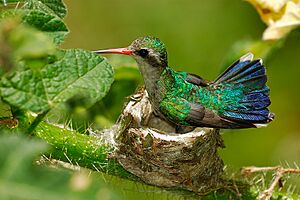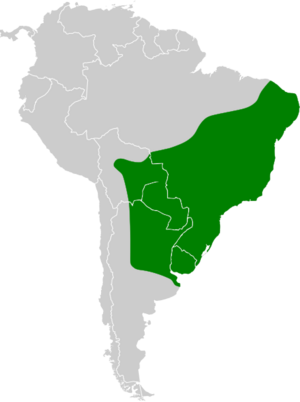Glittering-bellied emerald facts for kids
Quick facts for kids Glittering-bellied emerald |
|
|---|---|
 |
|
| Male | |
 |
|
| Female on nest | |
| Conservation status | |
| Scientific classification | |
| Genus: |
Chlorostilbon
|
| Species: |
lucidus
|
 |
|
| Synonyms | |
|
Chlorostilbon aureoventris (D'Orbigny and Lafresnaye, 1838) |
|
The glittering-bellied emerald (Chlorostilbon lucidus) is a beautiful type of hummingbird. These tiny, colorful birds are known for their shimmering feathers. You can find them in parts of South America, including Argentina, Bolivia, Brazil, Paraguay, and Uruguay. They are part of a group of hummingbirds often called "emeralds" because of their bright, jewel-like colors.
Contents
About This Hummingbird
Its Scientific Name
Every animal has a special scientific name that scientists around the world use. For the glittering-bellied emerald, its main scientific name is Chlorostilbon lucidus. This name helps everyone know exactly which bird they are talking about.
Different Types of Glittering-Bellied Emeralds
Within this species, there are a few slightly different groups called subspecies. Scientists have identified three main ones:
- C. l. pucherani lives in eastern Brazil.
- C. l. lucidus (the main type) is found in Bolivia, Paraguay, central-west Brazil, and northwest Argentina.
- C. l. berlepschi lives in southern Brazil, Uruguay, and northeast Argentina.
Sometimes, a fourth subspecies called C. l. igneous is also mentioned. These small differences often relate to where the birds live.
What Does It Look Like?
Size and Weight
The glittering-bellied emerald is a small bird. Males are about 9.5 to 10.5 centimeters (3.7 to 4.1 inches) long. They weigh between 3 to 3.8 grams (about the weight of two paper clips!). Females are a bit smaller, around 7.5 to 8.5 centimeters (3 to 3.3 inches) long. They weigh 3 to 4.5 grams. Both males and females have a short, straight beak. The male's beak is red with a black tip, while the female's is black on the outer half and red closer to her face.
Colors and Feathers
Male glittering-bellied emeralds are very colorful. Their heads and backs are a dull bronzy-green, and their bellies are a shiny blue-green or bronze. Their tails are a dark, shiny blue and slightly forked.
Female birds have slightly different colors. Their heads and backs are a golden-green. Their tail feathers are steel blue with gray tips, shaped like a "V". Females also have a grayish-white stripe behind their eyes. Their throats are whitish, fading to a pale brownish-gray on their chests and bellies.
Some subspecies have slight color variations. For example, C. l. berlepschi has pure green upperparts instead of golden-green.
Sounds and Calls
These hummingbirds make several interesting sounds. Their song is a high-pitched, cricket-like trill that they repeat. When they are feeding or hovering, they often make a short, dry, scratchy rattle sound, like "trrrr" or "krrr." During arguments with other birds, they might make a fast series of "tsee-tsee-tsee-tsu-tsew-tsew-tsew" notes.
Where Does It Live?
Its Home Range
The glittering-bellied emerald lives across a wide area of South America. Different subspecies are found in specific regions. For example, C. l. pucherani lives in eastern Brazil. The main subspecies, C. l. lucidus, is found in eastern Bolivia, Paraguay, and parts of Brazil and Argentina. Another subspecies, C. l. berlepschi, lives in southern Brazil, Uruguay, and northeastern Argentina. Sometimes, these birds have been seen in Chile and Peru, but they don't usually live there.
Preferred Habitats
These hummingbirds like many different kinds of open or partly open places. You can find them in scrublands, savannas (grassy plains with scattered trees), and grasslands. They also live at the edges of forests, and even in parks and gardens in towns. They can live from sea level up to about 3,500 meters (11,500 feet) high. However, they are most commonly found between 500 and 3,500 meters (1,600 to 11,500 feet) in elevation. They usually stay in one area, but sometimes they might travel to new places.
How It Behaves
Feeding Habits
The glittering-bellied emerald is always busy looking for food. It mostly drinks nectar from many different kinds of flowering plants. It often follows a regular path, visiting the same flowers over and over again. Sometimes, if it can't reach the nectar from the flower's opening, it will poke a hole at the base of the flower to get it. These birds usually feed between 4 and 12 meters (13 to 39 feet) above the ground.
Besides nectar, they also eat small insects. They catch insects by waiting on a perch and then flying out to snatch them in mid-air. They have even been seen eating a sweet liquid called honeydew, which is made by some insects.
Reproduction and Life Cycle
The breeding season for the glittering-bellied emerald lasts from at least August to February. The female builds a small, cup-shaped nest. She uses fine plant fibers and strips of bark, holding them together with spiderwebs. She lines the inside with soft materials and covers the outside with lichen and other things to help hide it.
The nest is usually placed on a thin branch of a small tree. However, nests have also been found attached to exposed roots about 1 meter (3 feet) above the ground. The female lays two eggs and keeps them warm for about 14 days. After the chicks hatch, they stay in the nest for about 20 to 22 days before they are ready to fly.
Conservation Status
The IUCN (International Union for Conservation of Nature) has listed the glittering-bellied emerald as a species of "Least Concern." This means that scientists are not worried about it becoming endangered anytime soon. It lives in a very large area, and it is considered common in many places. For example, it's the most commonly seen hummingbird in its part of Argentina. These birds also live in several protected areas and are comfortable living in gardens, parks, and plantations, which helps them thrive.


